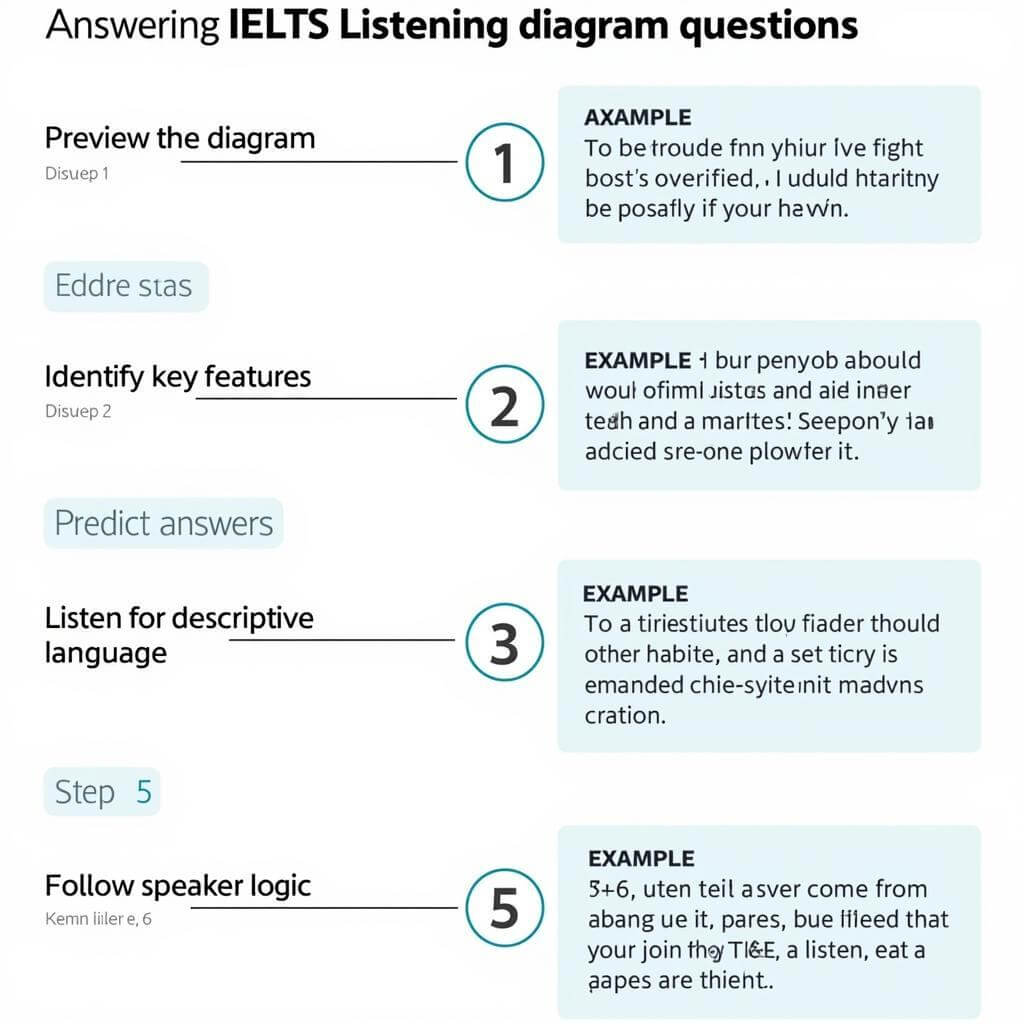Diagrams play a crucial role in the IELTS Listening test, often appearing in sections 2 and 3. Understanding how to approach and answer questions related to diagrams can significantly boost your score. As an experienced IELTS instructor, I’ll guide you through the process of tackling diagram-based questions effectively.
Understanding Diagram Questions in IELTS Listening
Diagram questions in IELTS Listening typically require you to label parts of an image or complete a visual representation based on the audio information. These questions test your ability to comprehend spoken descriptions and match them to visual elements.
What has the woman lost ielts listening questions often involve similar skills of matching audio cues to visual information, making them excellent practice for diagram-based tasks.
Types of Diagrams You May Encounter
- Floor plans
- Machine parts
- Processes or cycles
- Maps
- Organizational charts
Strategies for Answering Diagram Questions
1. Preview the Diagram
Before the audio begins, take a moment to study the diagram carefully. Familiarize yourself with its layout, labels, and any existing information. This preview will help you anticipate the type of information you’ll need to listen for.
2. Identify Key Features
Look for prominent features or sections in the diagram. These are likely to be mentioned in the audio and could be potential answers.
3. Predict Possible Answers
Based on the diagram and question types, try to predict what kind of information might be required. This could include:
- Names of specific parts
- Directions or locations
- Numbers or measurements
- Materials or substances
4. Listen for Descriptive Language
Pay close attention to descriptive words and phrases that might help you locate the correct part of the diagram. Speakers often use terms like:
- “On the left/right”
- “At the top/bottom”
- “Next to”
- “Between”
- “In the center”
What helped stewart ielts listening answers can provide additional practice in identifying key information from audio cues, which is essential for diagram questions.
5. Follow the Speaker’s Logic
Diagram descriptions often follow a logical order. Pay attention to transition words that indicate the speaker is moving to a new part of the diagram, such as “next,” “then,” or “moving on to.”

Common Pitfalls and How to Avoid Them
-
Overthinking: Don’t spend too much time on one question. If you’re unsure, make an educated guess and move on.
-
Ignoring context: Always consider the overall context of the diagram and the audio passage.
-
Mishearing similar words: Be cautious of words that sound alike but have different meanings.
-
Spelling errors: Remember that correct spelling is crucial in IELTS Listening.
-
Missing singular/plural distinctions: Pay attention to whether the answer should be singular or plural.
Practice Exercises
To improve your skills in answering diagram questions, try these exercises:
- Study various types of diagrams and practice describing them orally.
- Listen to descriptions of objects or processes and try to sketch them.
- Use past IELTS papers to practice with authentic diagram questions.
- Time yourself to get used to the pressure of the real test.
- Record your own descriptions of diagrams and listen back to improve your descriptive language.
Tips for Test Day
-
Stay calm: Nervousness can affect your listening skills. Take deep breaths and stay focused.
-
Use the example: The first question is usually an example. Use it to understand the task and familiarize yourself with the speaker’s voice.
-
Write as you listen: Don’t wait until the end to fill in your answers. Write them as you hear the information.
-
Check your work: If time allows, quickly review your answers for spelling and logic.
-
Transfer answers carefully: When transferring answers to the answer sheet, double-check that you’ve put them in the correct spaces.
Conclusion
Mastering diagram questions in IELTS Listening requires practice and strategy. By familiarizing yourself with different diagram types, honing your descriptive language skills, and following the tips provided, you’ll be well-prepared to tackle these questions confidently. Remember, the key is to stay focused, predict possible answers, and listen actively for specific details. With consistent practice, you’ll find that diagram questions can become one of your strengths in the IELTS Listening test.